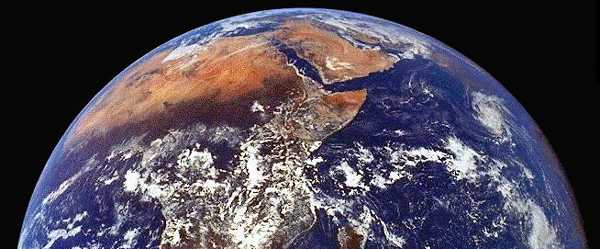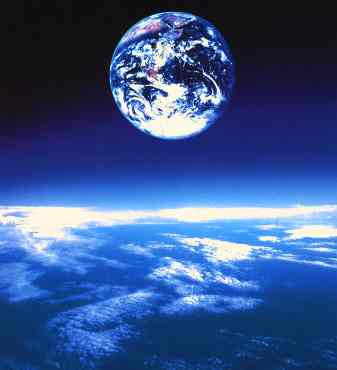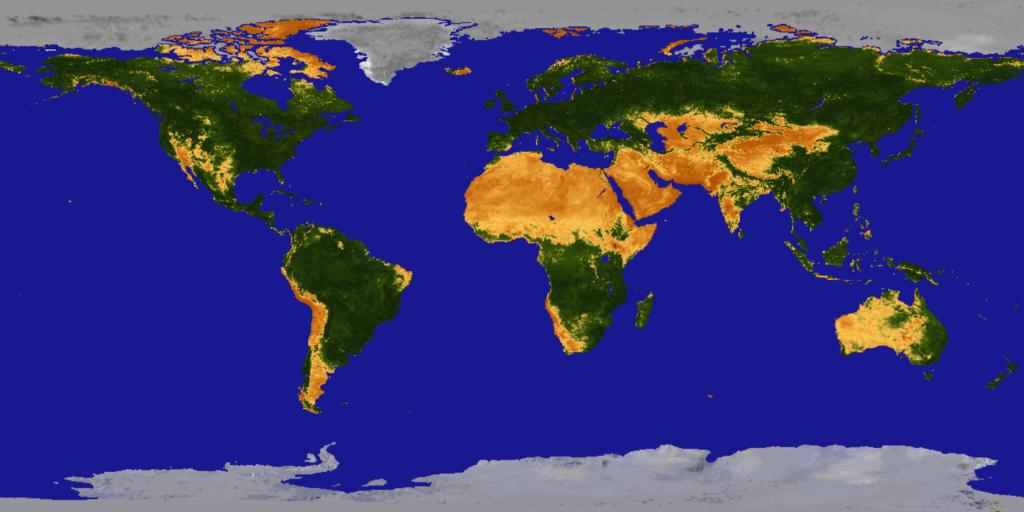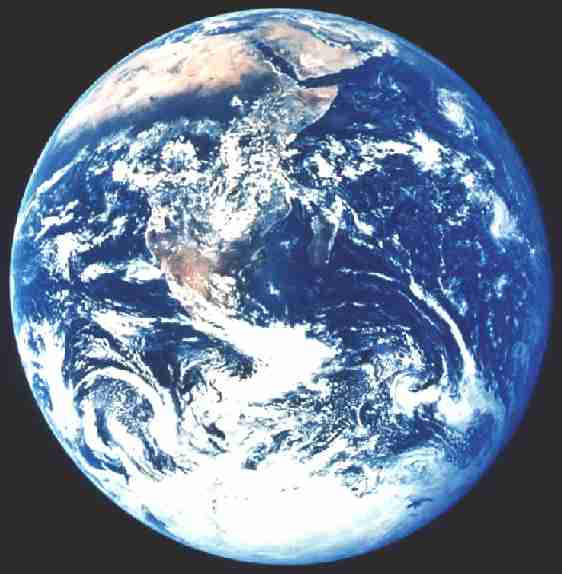|
THE EARTH
|
|
|
HOME | BIOLOGY | FILMS | GEOGRAPHY | HISTORY | INDEX | INVESTORS | MUSIC | NEWS | SOLAR BOATS | SPORT |
|
|
Earth is the third planet from the Sun and the fifth largest: orbit: 149,600,000 km (1.00 AU) from Sun
diameter: 12,756.3 km
mass: 5.972e24 kg
Earth is the only planet whose English name does not derive from Greek/Roman mythology. The name derives from Old English and Germanic. There are, of course, hundreds of other names for the planet in other languages. In Roman Mythology, the goddess of the Earth was Tellus - the fertile soil (Greek: Gaia, terra mater - Mother Earth).
It was not until the time of Copernicus (the sixteenth century) that it was understood that the Earth is just another planet.
Earth, of course, can be studied without the aid of spacecraft. Nevertheless it was not until the twentieth century that we had maps of the entire planet. Pictures of the planet taken from space are of considerable importance; for example, they are an enormous help in weather prediction and especially in tracking and predicting hurricanes. And they are extraordinarily beautiful.
The Earth is
divided into several layers which have distinct chemical
and seismic properties (depths in km): 0- 40 Crust 40- 400 Upper mantle 400- 650 Transition region 650-2700 Lower mantle 2700-2890 D'' layer 2890-5150 Outer core 5150-6378 Inner core
The crust varies considerably in thickness, it is thinner under the oceans, thicker under the continents. The inner core and crust are solid; the outer core and mantle layers are plastic or semi-fluid. The various layers are separated by discontinuities which are evident in seismic data; the best known of these is the Mohorovicic discontinuity between the crust and upper mantle.
Most of the mass of the Earth is in the mantle, most of the rest in the core; the part we inhabit is a tiny fraction of the whole (values below x10^24 kilograms):
atmosphere = 0.0000051 oceans = 0.0014 crust = 0.026 mantle = 4.043 outer core = 1.835 inner core = 0.09675 The core is
probably composed mostly of iron (or nickel/iron) though
it is possible that some lighter elements may be
present, too. Temperatures at the center of the core may
be as high as 7500 K, hotter than the surface of the Sun.
The lower mantle is probably mostly silicon, magnesium
and oxygen with some iron, calcium and aluminum. The
upper mantle is mostly olivene and pyroxene
(iron/magnesium silicates),
calcium and aluminum. We know most of this only from
seismic techniques; samples from the upper mantle arrive
at the surface as lava from volcanoes but the majority
of the Earth is inaccessible. The crust is primarily
quartz (silicon dioxide) and other silicates like
feldspar. Taken as a whole, the Earth's chemical
composition (by mass) is: 34.6% Iron
29.5% Oxygen
15.2% Silicon
12.7% Magnesium
2.4% Nickel
1.9% Sulfur
0.05% Titanium
The Earth is the densest major body in the solar system.
The other terrestrial planets probably have similar structures and compositions with some differences: the Moon has at most a small core; Mercury has an extra large core (relative to its diameter); the mantles of Mars and the Moon are much thicker; the Moon and Mercury may not have chemically distinct crusts; Earth may be the only one with distinct inner and outer cores. Note, however, that our knowledge of planetary interiors is mostly theoretical even for the Earth.
Unlike the other terrestrial planets, Earth's crust is divided into several separate solid plates which float around independently on top of the hot mantle below. The theory that describes this is known as plate tectonics. It is characterized by two major processes: spreading and subduction. Spreading occurs when two plates move away from each other and new crust is created by upwelling magma from below. Subduction occurs when two plates collide and the edge of one dives beneath the other and ends up being destroyed in the mantle. There is also transverse motion at some plate boundaries (i.e. the San Andreas Fault in California) and collisions between continental plates (i.e. India/Eurasia). There are (at present) eight major plates:
There are also twenty or more small plates such as the Arabian, Cocos, and Philippine Plates. Earthquakes are much more common at the plate boundaries. Plotting their locations makes it easy to see the plate boundaries (right).
The Earth's surface is very young. In the relatively short (by astronomical standards) period of 500,000,000 years or so erosion and tectonic processes destroy and recreate most of the Earth's surface and thereby eliminate almost all traces of earlier geologic surface history (such as impact craters). Thus the very early history of the Earth has mostly been erased. The Earth is 4.5 to 4.6 billion years old, but the oldest known rocks are about 4 billion years old and rocks older than 3 billion years are rare. The oldest fossils of living organisms are less than 3.9 billion years old. There is no record of the critical period when life was first getting started.
71 Percent of the Earth's surface is covered with water. Earth is the only planet on which water can exist in liquid form on the surface (though there may be liquid ethane or methane on Titan's surface and liquid water beneath the surface of Europa). Liquid water is, of course, essential for life as we know it. The heat capacity of the oceans is also very important in keeping the Earth's temperature relatively stable. Liquid water is also responsible for most of the erosion and weathering of the Earth's continents, a process unique in the solar system today (though it may have occurred on Mars in the past).
The Earth's atmosphere is 77% nitrogen, 21% oxygen, with traces of argon, carbon dioxide and water. There was probably a very much larger amount of carbon dioxide in the Earth's atmosphere when the Earth was first formed, but it has since been almost all incorporated into carbonate rocks and to a lesser extent dissolved into the oceans and consumed by living plants. Plate tectonics and biological processes now maintain a continual flow of carbon dioxide from the atmosphere to these various "sinks" and back again. The tiny amount of carbon dioxide resident in the atmosphere at any time is extremely important to the maintenance of the Earth's surface temperature via the greenhouse effect. The greenhouse effect raises the average surface temperature about 35 degrees C above what it would otherwise be (from a frigid -21 C to a comfortable +14 C); without it the oceans would freeze and life as we know it would be impossible.
The presence of free oxygen is quite remarkable from a chemical point of view. Oxygen is a very reactive gas and under "normal" circumstances would quickly combine with other elements. The oxygen in Earth's atmosphere is produced and maintained by biological processes. Without life there would be no free oxygen.
The interaction of the Earth and the Moon slows the Earth's rotation by about 2 milliseconds per century. Current research indicates that about 900 million years ago there were 481 18-hour days in a year.
Earth has a modest magnetic field produced by electric currents in the outer core. The interaction of the solar wind, the Earth's magnetic field and the Earth's upper atmosphere causes the auroras (see the Interplanetary Medium). Irregularities in these factors cause the magnetic poles to move and even reverse relative to the surface; the geomagnetic north pole is currently located in northern Canada.
The Earth's magnetic field and its interaction with the solar wind also produce the Van Allen radiation belts, a pair of doughnut shaped rings of ionized gas (or plasma) trapped in orbit around the Earth. The outer belt stretches from 19,000 km in altitude to 41,000 km; the inner belt lies between 13,000 km and 7,600 km in altitude.
Earth's Satellite
Earth has only one natural satellite, the Moon. But
Distance Radius Mass
Satellite (000 km) (km) (kg)
--------- -------- ------ -------
Moon 384 1738 7.35e22
Open Issues
Healthier alternative tastes for adventure capitalists
|
|
|
This
website
is Copyright © 1999 & 2012 NJK. The bird |
|
|
AUTOMOTIVE | BLUEPLANET | ELECTRIC CARS | ELECTRIC CYCLES | SOLAR CARS |





